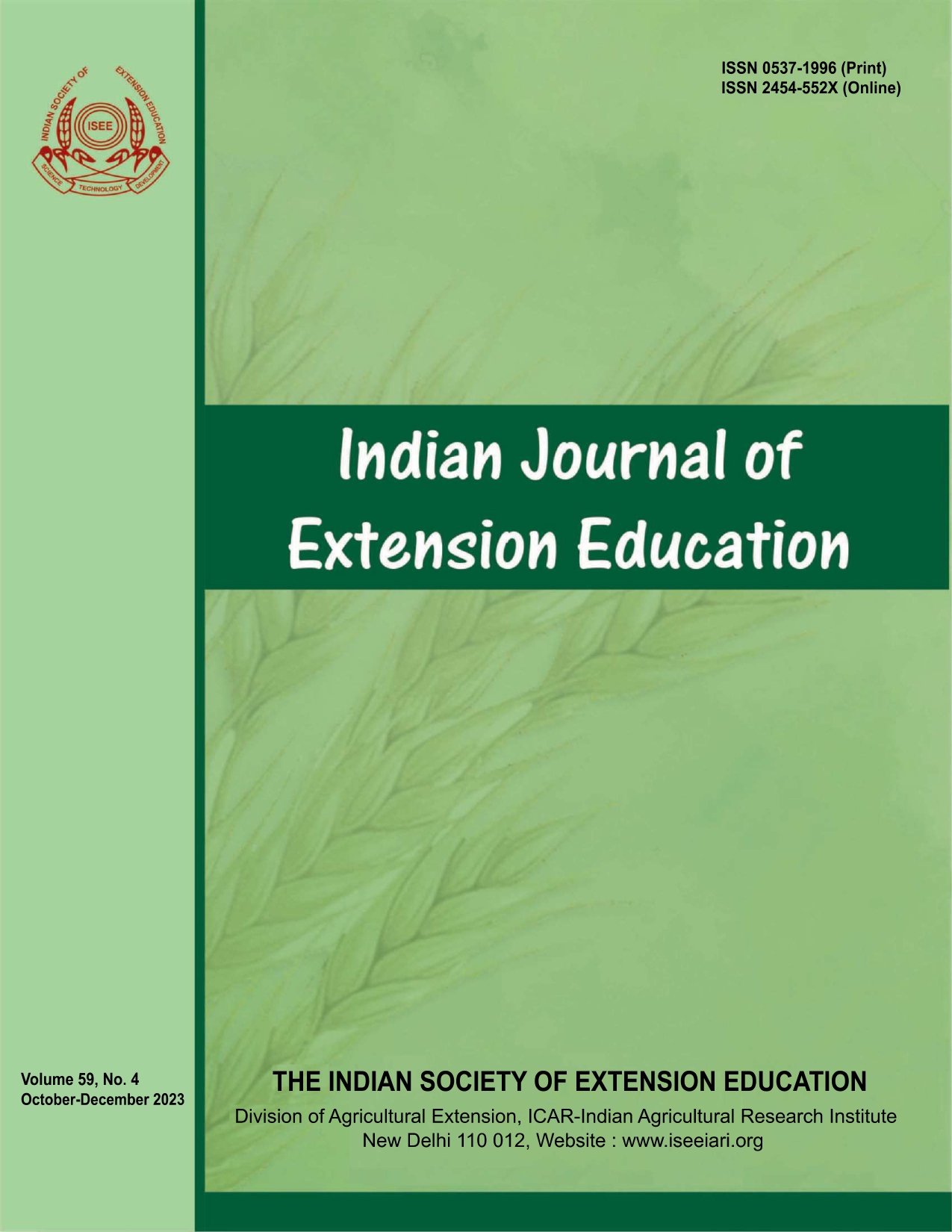Knowledge Level and Adoption Behaviour of Maize Growers in Selected Districts of Nagaland, India
DOI:
https://doi.org/10.48165/IJEE.2023.59406Keywords:
Maize, Knowledge, Adoption, Knowledge index, Adoption index, NagalandAbstract
The paper examined the knowledge level and adoption behaviour of maize growers in Nagaland. Altogether, 120 respondents were selected following proportionate random sampling from 8 villages from four blocks of two districts. Two indices, namely, knowledge and adoption indices were developed. The maize growers had inadequate knowledge of improved cultivation practices of maize. Respondents had inadequate adoption index. The variables- age, marital status, and family size had having statistically significant relationship at 5% with knowledge level. Simultaneously, income from maize cultivation, informal information, mass media, social participation, and experience in maize cultivation established a statistically significant relationship at 1% with the knowledge level. Similarly, marital status, education, and informal sources of information established a statistically significant relationship at 5% with the adoption level, and annual income was found to be statistically significant at 1% with the adoption level. It is recommended that all the stakeholders and extension systems take the initiative to improve maize cultivation in Nagaland, which will accelerate the socio-economic up-scaling of the study community. Concerned authorities may also carry out frequent capacity development and technology transfer drives for improvement.
Downloads
References
Acharya, S., Acharya, S. K., Mandal, T. K., Mohanty, B. K., & Haque, M. (2023). Information receiving behavior of farmers: the structural and functional analysis. Indian Journal of Extension Education, 59(3), 58–62. Retrieved from https://epubs.icar.org.in/ index.php/IJEE/article/view/134079
Ao, S., & Patra N. K. (2018). Performance of integrated watershed management programme (IWMP) in social inclusion in Wokha district of Nagaland, India. Indian Research Journal of Extension Education, 18(3), 38-42.
Benjongtoshi & Patra N. K. (2021a). An assessment of livelihood activities maintained by French bean growers in Nagaland. International Journal of Extension Education, XVII, 43-49.
Benjongtoshi & Patra, N. K. (2021). Socio-economic and livelihood features of French bean growers: Evidence from Kiphire District, Nagaland. Indian Research Journal of Extension Education, 21(1), 24-29.
Chandran, V., & Chakravarty, R. (2022). Extent of adoption of available components in the IFS units of Kerala. Indian Journal of Extension Education, 58(4), 130–133. Retrieved from https:/ /epubs.icar.org.in/index.php/IJEE/article/view/128452
INDIAN JOURNAL OF EXTENSION EDUCATION
Duflo, E., Kremer, M., & Robinson, J. (2011). Nudging farmers to use fertilizer: Theory and experimental evidence from Kenya. American Economic Review, 101(6), 2350–2390.
Gamlin, M., Patra, N. K., Benjongtoshi, & Das, S. (2021). Pineapple (Ananas comosus L.) cultivation- A sustainable livelihood strategy in Arunachal Pradesh, India. Journal of Community Mobilization and Sustainable Development, 16(3), 933-938.
Govt. of Nagaland. (2020). Statistical Handbook of Nagaland 2019- 2020. Directorate of Economics & Statistics Nagaland: Kohima. Kumari, V., Chander, S., Malik, K., & Kaur, B. (2022). Assessment of knowledge and adoption of drip irrigation in cotton crop among farmers of Haryana. Indian Journal of Extension Education, 58(4), 149–154. Retrieved from https://epubs.icar.org.in/ index.php/IJEE/article/view/128456
Mason, N. M., & Smale, M. (2013). Impacts of subsidized hybrid seed on indicators of economic well being among smallholder maize growers in Zambia. Agricultural Economics, 44(6), 659–670.
Nain, M. S., Bhagat, G. R., Kher, S. K., Slathia, P. S., & Ahmad, N. (2007) Adoption of maize production technology in intermediate zone of Rajouri district of J&K. Journal of Research SKUAST Jammu, 6(1), 61-66.
NSSO (National Sample Survey Organisation). (2005). Situation assessment survey of farmers: Access to modern technology for farming, 59th round (January–December 2003). Report No. 499(59/33/2). New Delhi: Ministry of Statistics and Programme Implementation.
Patra, N. K., & Babu, S. C. (2017). Mapping Indian Agricultural emission: Lessons for food system transformation and policy support for climate-smart agriculture. IFPRI, Discussion paper
Retrieved from: https://www.ifpri.org/publication/ mapping-indian-agricultural-emissions-lessons-food-system transformation-and-policy
Patra, N. K., & Babu, S. C. (2023). Institutional and policy process for climate-smart agriculture: evidence from Nagaland State, India. Journal of Water and Climate Change, 14(1), 1-16. doi: 10.2166/ wcc.2022.024
Patra, N. K., & Lianzami, L. (2021). Socio-economic status and constraints faced by Chow-chow [Sechium edule (Jacq.) Sw.] growers in Aizawl district, Mizoram, India. Journal of Community Mobilization and Sustainable Development, 16(2), 343-350.
Patra, N. K., Moasunep. & Sailo, Z. (2020). Assessing socioeconomic and modernization status of rubber (Hevea brasiliensis) Growers: Evidence from Nagaland, North Eastern Himalayan Region, India. Indian Research Journal of Extension Education, 20(2&3), 45-51.
Reddy, S. R. (2004). Agronomy of field crops, Kalyani publishers 2012, New Delhi-110002, 176-181.
Rogers, E. M. (2003). Diffusion of Innovations, Free Press, 5th edition, 1-578.
Varshney, D., Joshi, P. K., & Roy, D. (2019). Estimating the adoption of modern cultivars in Rajasthan a descriptive analysis. IFPRI Discussion Paper 01806. https://doi.org/10.2499/p15738coll2. 133080
Varshney, D., Joshi, P. K., & Roy, D. (2019a). Identifying innovators and early adopters of agricultural technology a case of wheat varieties in Rajasthan, India. IFPRI Discussion Paper 01808. https://doi.org/10.2499/p15738coll2.133127
Published
Issue
Section
License

This work is licensed under a Creative Commons Attribution-NonCommercial-NoDerivatives 4.0 International License.


